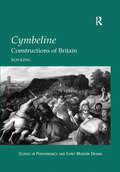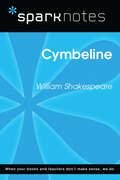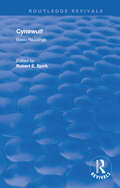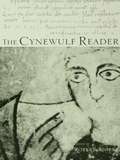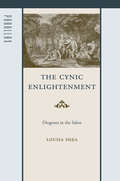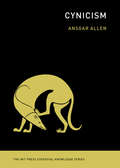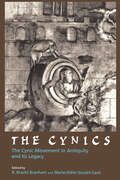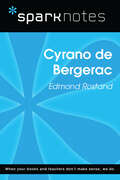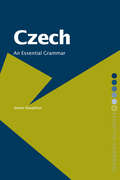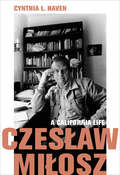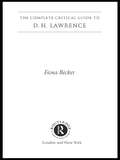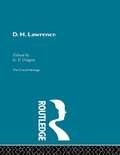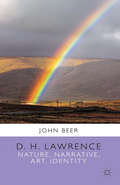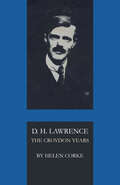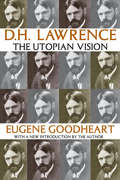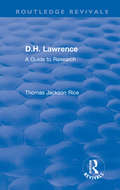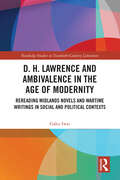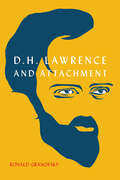- Table View
- List View
The Cylinder: Kinematics of the Nineteenth Century (FlashPoints)
by Helmut Müller-SieversThe Cylinder investigates the surprising proliferation of cylindrical objects in the nineteenth century, such as steam engines, phonographs, panoramas, rotary printing presses, silos, safety locks, and many more. Examining this phenomenon through the lens of kinematics, the science of forcing motion, Helmut Müller-Sievers provides a new view of the history of mechanics and of the culture of the industrial revolution, including its literature, that focuses on the metaphysics and aesthetics of motion. Müller-Sievers explores how nineteenth-century prose falls in with the specific rhythm of cylindrical machinery, re-imagines the curvature of cylindrical spaces, and conjoins narrative progress and reflection in a single stylistic motion. Illuminating the intersection of engineering, culture, and literature, he argues for a concept of culture that includes an epoch’s relation to the motion of its machines.
Cymbeline: Constructions of Britain (Studies in Performance and Early Modern Drama)
by Ros KingIn Cymbeline: Constructions of Britain, Ros King argues that because of previous misunderstanding of the nature and history of tragi-comedy, critics have mistaken the tone of Shakespeare's play. Although it is often dismissed as a pedestrian 'romance', or at best a self-parodic reworking of previous Shakespearean themes, she proposes that Cymbeline's fantastical, black comedy and its facility for keeping multiple plots all in the air together are in fact a tour de force of dramaturgical construction. King's multi-faceted approach combines strikingly perceptive commentaries on the text's most notoriously difficult passages, with descriptions of performance, and analysis of the text's historical, cultural and literary contexts. In this wide-ranging study, the play becomes a focus for considering early modern England's encounters with its Scottish king, with religious struggle in Europe, and with the indigenous peoples of North America. King demonstrates that the play's dramaturgical structure enables it to raise daring questions about the nature of government, the rights of birth and of succession, and the concepts of 'empire', supplying a curiously bitter and indeed tragic undercurrent to the final 'happy' ending while attempting to neutralise contemporary religious conflict. Having explored the influences that went into the writing of Cymbeline, King devotes her final chapter to the play's later reception and shows how it has been made to respond to different cultural pressures over time. Using as a test case the outrageously ebullient production at Shakespeare Santa Cruz, 2000, for which she was dramaturg, she outlines an ethic for interpretation and considers the problems to be faced in both criticism and performance when realising the text as living theatre for a modern audience.
Cymbeline (SparkNotes Literature Guide Series)
by SparkNotesCymbeline (SparkNotes Literature Guide) by William Shakespeare Making the reading experience fun! Created by Harvard students for students everywhere, SparkNotes is a new breed of study guide: smarter, better, faster.Geared to what today's students need to know, SparkNotes provides:chapter-by-chapter analysis explanations of key themes, motifs, and symbols a review quiz and essay topics Lively and accessible, these guides are perfect for late-night studying and writing papers.
Cynewulf: Basic Readings (Basic Readings In Anglo-saxon England Ser.)
by Robert E. BjorkTwo original essays and 16 published since 1950 offer a comprehensive view of Cynewulf, his language, and his poetry. The collection contains important new statements on dates, provenance, and canon by R.D. Fulk and Patrick W. Conner, four influential essays that thoroughly explore Cynewulf's runic signature and poetic style, and major contributions to our understanding of the four signed poems of Cynewulf, Fates of the Apostles, Christ II, Juliana, and Elene. Three essays are devoted to each of these poems, and the essays themselves exemplify a broad range of approaches to this highly elusive Anglo-Saxon poet. The volume complements existing book-length treatments of the subject and will be welcome to scholars and students who need the foundations of Cynewulf scholarship at their fingertips.
The Cynewulf Reader (Basic Readings in Anglo-Saxon England #4)
by Robert E. BjorkThe Cynewulf Reader is a collection of classic and original essays presenting a comprehensive view of the elusive Anglo-Saxon poet Cynewulf, his language, and his work.
The Cynic Enlightenment: Diogenes in the Salon (Parallax: Re-visions of Culture and Society)
by Louisa SheaThis original study reveals the importance of ancient Cynicism in defining the Enlightenment and its legacy. Louisa Shea explores modernity's debt to Cynicism by examining the works of thinkers who turned to the ancient Cynics as a model for reinventing philosophy and dared to imagine an alliance between a socially engaged Enlightenment and the least respectable of early Greek philosophies. While Cynicism has always resided on the fringes of philosophy, Shea argues, it remained a vital touchstone for writers committed to social change and helped define the emerging figure of the public intellectual in the 18th century.Shea's study brings to light the rich legacy of ancient Cynicism in modern intellectual, philosophical, and literary life, both in the 18th-century works of Diderot, Rousseau, Wieland, and Sade, and in recent writings by Michel Foucault and Peter Sloterdijk. Featuring an important new perspective on both Enlightenment thought and its current scholarly reception, The Cynic Enlightenment will interest students and scholars of the Enlightenment and its intellectual legacy, 18th-century studies, literature, and philosophy.
Cynicism (The MIT Press Essential Knowledge Series)
by Ansgar AllenA short history of cynicism, from the fearless speech of the ancient Greeks to the jaded negativity of the present. Everyone's a cynic, yet few will admit it. Today's cynics excuse themselves half-heartedly—“I hate to be a cynic, but..."—before making their pronouncements. Narrowly opportunistic, always on the take, contemporary cynicism has nothing positive to contribute. The Cynicism of the ancient Greeks, however, was very different. This Cynicism was a marginal philosophy practiced by a small band of eccentrics. Bold and shameless, it was committed to transforming the values on which civilization depends. In this volume of the MIT Press Essential Knowledge series, Ansgar Allen charts the long history of cynicism, from the “fearless speech” of Greek Cynics in the fourth century BCE to the contemporary cynic's lack of social and political convictions.Allen describes ancient Cynicism as an improvised philosophy and a way of life disposed to scandalize contemporaries, subjecting their cultural commitments to derision. He chronicles the subsequent “purification” of Cynicism by the Stoics; Renaissance and Enlightenment appropriations of Cynicism, drawing on the writings of Shakespeare, Rabelais, Rousseau, de Sade, and others; and the transition from Cynicism (the philosophy) to cynicism (the modern attitude), exploring contemporary cynicism from the perspectives of its leftist, liberal, and conservative critics. Finally, he considers the possibility of a radical cynicism that admits and affirms the danger it poses to contemporary society.
The Cynics: The Cynic Movement in Antiquity and Its Legacy (Hellenistic Culture and Society #23)
by R. Bracht Branham Marie-Odile Goulet-CazéThis collection of essays—the first of its kind in English—brings together the work of an international group of scholars examining the entire tradition associated with the ancient Cynics. The essays give a history of the movement as well as a state-of-the-art account of the literary, philosophical and cultural significance of Cynicism from antiquity to the present.Arguably the most original and influential branch of the Socratic tradition, Cynicism has become the focus of renewed scholarly interest in recent years, thanks to the work of Sloterdijk, Foucault, and Bakhtin, among others. The contributors to this volume—classicists, comparatists, and philosophers—draw on a variety of methodologies to explore the ethical, social and cultural practices inspired by the Cynics. The volume also includes an introduction, appendices, and an annotated bibliography, making it a valuable resource for a broad audience.
Cyrano de Bergerac (SparkNotes Literature Guide Series)
by SparkNotesCyrano de Bergerac (SparkNotes Literature Guide) by Edmond Rostand Making the reading experience fun! Created by Harvard students for students everywhere, SparkNotes is a new breed of study guide: smarter, better, faster.Geared to what today's students need to know, SparkNotes provides:chapter-by-chapter analysis explanations of key themes, motifs, and symbols a review quiz and essay topics Lively and accessible, these guides are perfect for late-night studying and writing papers.
Czech: An Essential Grammar (Routledge Essential Grammars)
by James NaughtonCzech: An Essential Grammar is a practical reference guide to the core structures and features of modern Czech. Presenting a fresh and accessible description of the language, this engaging grammar uses clear, jargon-free explanations and sets out the complexities of Czech in short, readable sections. Suitable for either independent study or for students in schools, colleges, universities and adult classes of all types, key features include: * focus on the morphology and syntax of the language* clear explanations of grammatical terms * full use of authentic examples* detailed contents list and index for easy access to information. With an emphasis on the Czech that native speakers use today, Czech: An Essential Grammar will help students to read, speak and write the language with greater confidence.
The Czech Manuscripts: Forgery, Translation, and National Myth (NIU Series in Slavic, East European, and Eurasian Studies)
by David L. CooperThe Czech Manuscripts is dedicated to one of the most important literary forgeries on the model of Macpherson's Ossianic poetry. The Queen's Court and Green Mountain Manuscripts, discovered in 1817 and 1818, went on to play an outsized role in the Czech National Revival, functioning as founding texts of the national mythology and serving as sacred works in the long period when they were considered genuine. A successful literary forgery tells a lot about what a culture wants and needs at a particular moment. One fascinating aspect of this story is how a successful fake was able to function in an integral way as part of the Czech cultural revival of the nineteenth century, both because it played to expectations and nationalist values and because it met real cultural needs in many ways better than genuine historical literary works and artefacts. Also fascinating is the vainglorious Václav Hanka, a prolific and dedicated forger who was likely the center of the conspiratorial ring that created the manuscripts and who went on as the librarian of the Czech National Museum to alter a number of others. David Cooper analyzes what made the Manuscripts a convincing imitation of their Serbian and Russian models. He looks at how translation shaped their composition and at the benefit ofexamining them as pseudotranslations, and investigates the quasi-religious rituals and commemorative practices that developed around them. The Czech Manuscripts brings the Czech experience into the broader developments of European history.
Czeslaw Milosz: A California Life
by Cynthia L. HavenCzesław Miłosz, one of the greatest poets and thinkers of the past hundred years, is not generally considered a Californian. But the Nobel laureate spent four decades in Berkeley—more time than any other single place he lived—and he wrote many of his most enduring works there. This is the first book to look at his life through a California lens. Filled with original research and written with the grace and liveliness of a novel, it is both an essential volume for his most devoted readers and a perfect introduction for newcomers. Miłosz was a premier witness to the sweep of the twentieth century, from the bombing of Warsaw in World War II to the student protests of the sixties and the early days of the high-tech boom. He maintained an open-minded but skeptical view of American life, a perspective shadowed by the terrors he experienced in Europe. In the light of recent political instability and environmental catastrophe, his poems and ideas carry extra weight, and they are ripe for a new generation of readers to discover them. This immersive portrait demonstrates what Miłosz learned from the Golden State, and what Californians can learn from him.
D C-T!
by Joana Avillez Molly YoungA joy-inducing illustrated book about New York City in the ingenious style of William Steig's classic CDB!Just as there are few cities as storied and replete with life as New York City, there are few illustrators or writers who have charmed as many generations as William Steig. To Molly Young and Joana Avillez, a connection between the two seemed obvious, and so D C-T! ("The City!") was born.Using a playful phonetic language first invented by Steig in his now classic 1968 book CDB!--but which in today's world of text message and internet shorthand feels uncannily contemporary--Young and Avillez tell a different story on each page of this collection of illustrations stuffed to brim with humor and cleverness:"S L-I-F!" (It's alive!) A boy shouts gleefully at a pile of rubbish seething with rats"I M B-Z" (I'm busy) Declares the phone-wielding businesswoman to the would-be mugger"R U I?" (Are you high?) Asks the clerk at a bodega to the blissed out shopperBrought to life in Avillez's distinctively ebullient and droll style are precocious pets and pet-owners, iconic architecture, and startlingly intrepid anthropomorphic rats. At once recognizable, and imagined like never before, are the surprising, intoxicating, and not-always-entirely-welcome sights, sounds, and smells of New York City. Full of wit, romance, and sheer delight, D C-T! is both an affectionate portrait of the visual cornucopia that is New York City and a gracious love letter to the great William Steig, sure to enchant readers young and old alike just as his work has for half a century.
D.H. Lawrence (Routledge Guides to Literature)
by Fiona BecketSo many questions surround the key figures in the English literary canon, but most books focus on one aspect of an author's life or work, or limit themselves to a single critical approach. D. H. Lawrence is a comprehensive, user-friendly guide which: * offers basic information on Lawrence's, contexts and works* outlines the major critical issues surrounding his works, from the time they were written to the present* explain the full range of often very different critical views and interpretation* offer guides to further reading in each area discussed. This guidebook has a broad focus but one very clear aim: to equip you with all the knowledge you need to make your own new readings of the work of D. H. Lawrence.
D.H. Lawrence: Sons And Lovers:essays On Japanese History And Politics (Palgrave Master Guides #8)
by Fiona BecketThis set comprises 40 volumes covering 19th and 20th century European and American authors. These volumes will be available as a complete set, mini boxed sets (by theme) or as individual volumes. This second set compliments the first 68 volume set of Critical Heritage published by Routledge in October 1995.
D. H. Lawrence: Nature, Narrative, Art, Identity
by J. BeerA full account of Lawrence, ranging from his talent as a young writer to the continuing genius of his later work, and concentrating on his exceptionally acute powers of observation, both human and natural.
D. H. Lawrence
by John BeerA full account of Lawrence, ranging from his talent as a young writer to the continuing genius of his later work, and concentrating on his exceptionally acute powers of observation, both human and natural.
D. H. Lawrence: The Croydon Years
by Helen CorkeCroydon, England, was the setting of the famous three-way friendship of D. H. Lawrence, Jessie Chambers, and Helen Corke, all of whom made literary records of their association, and all of whom appeared as characters in Lawrence novels. Perhaps the most objective of these records were Helen Corke’s, which became difficult to acquire. Their scarcity and their continuing usefulness were the stimulus for publication of this volume, which contains in four statements Helen Corke’s “major comment on Lawrence the man and Lawrence the artist.” The “Portrait of D. H. Lawrence, 1909–1910,” a section from Corke’s unpublished autobiography, gives the reader glimpses into the earliest stages of the Lawrence-Corke friendship, when Lawrence worked to bring meaning back into Corke’s life after she had suffered a tragic loss. The “Portrait” tells of conversations before a log fire, German lessons, the reading of poetry, and sessions over Lawrence’s manuscript “Nethermere,” which the publishers renamed The White Peacock. In “Portrait,” Corke tells of working with Lawrence on revising the proofs of this book, of Lawrence’s encouragement of her own literary efforts, of their wandering together in the Kentish hill country, and of her first meeting with Jessie Chambers. “Lawrence’s ‘Princess’” continues the narrative of the triple friendship, carrying it to its sad ending, but with the focus on Jessie Chambers. Perceptively and sympathetically written, it throws a clarifying light on the psychology of Lawrence and presents with literary charm another human being—Jessie, the Miriam of Sons and Lovers. In combined narrative-critique method, Corke, in the essay “Concerning The White Peacock,” relates Lawrence’s problems in writing this novel and gives an analysis of its literary quality. Lawrence and Apocalypse is cast in the form of a “deferred conversation” in which Lawrence and Corke discuss his philosophical ideas as presented in his Apocalypse. Although the book was written to present Lawrence’s ideas, its significance reposes equally in Corke’s reaction to his thought. As a succinct statement of Lawrence’s teachings about the nature of humanity, it has unique value.
D. H. Lawrence: The Croydon Years
by Helen CorkeCroydon, England, was the setting of the famous three-way friendship of D. H. Lawrence, Jessie Chambers, and Helen Corke, all of whom made literary records of their association, and all of whom appeared as characters in Lawrence novels. Perhaps the most objective of these records were Helen Corke’s, which became difficult to acquire. Their scarcity and their continuing usefulness were the stimulus for publication of this volume, which contains in four statements Helen Corke’s “major comment on Lawrence the man and Lawrence the artist.” The “Portrait of D. H. Lawrence, 1909–1910,” a section from Corke’s unpublished autobiography, gives the reader glimpses into the earliest stages of the Lawrence-Corke friendship, when Lawrence worked to bring meaning back into Corke’s life after she had suffered a tragic loss. The “Portrait” tells of conversations before a log fire, German lessons, the reading of poetry, and sessions over Lawrence’s manuscript “Nethermere,” which the publishers renamed The White Peacock. In “Portrait,” Corke tells of working with Lawrence on revising the proofs of this book, of Lawrence’s encouragement of her own literary efforts, of their wandering together in the Kentish hill country, and of her first meeting with Jessie Chambers. “Lawrence’s ‘Princess’” continues the narrative of the triple friendship, carrying it to its sad ending, but with the focus on Jessie Chambers. Perceptively and sympathetically written, it throws a clarifying light on the psychology of Lawrence and presents with literary charm another human being—Jessie, the Miriam of Sons and Lovers. In combined narrative-critique method, Corke, in the essay “Concerning The White Peacock,” relates Lawrence’s problems in writing this novel and gives an analysis of its literary quality. Lawrence and Apocalypse is cast in the form of a “deferred conversation” in which Lawrence and Corke discuss his philosophical ideas as presented in his Apocalypse. Although the book was written to present Lawrence’s ideas, its significance reposes equally in Corke’s reaction to his thought. As a succinct statement of Lawrence’s teachings about the nature of humanity, it has unique value.
D. H. Lawrence
by Ronald P. DraperLawrence is now an accepted major writer--with W. B. Yeats and T. S. Eliot, I should say, he is one of the three most important writers in English in the twentieth century--and it is fitting that his work should be accorded the same critical treatment that is given to other major writers. Moreover, Lawrence's own famous dictum--"Never trust the artist. Trust the tale. The proper function of a critic is to save the tale from the artist who created, it."--should also be applied to his own work. Lawrence is read, and will continue to be, for his novels, tales, and poems; and these must be preserved, not only from injudicious admirers and detractors, but, where necessary, from the misrepresentations that derive from Lawrence's own didactic rather than artistic self.
D.H. Lawrence: The Utopian Vision
by Eugene GoodheartThe dominant view of D.H. Lawrence's work has long been that of F. R. Leavis, who confined Lawrence within an exclusively ethical and artistic tradition. In D.H. Lawrence: The Utopian Vision, Eugene Goodheart widens the context in which Lawrence should be understood to include European as well as English writers - Blake, Nietzsche, Rilke, and Freud among others. Goodheart shows that the characteristic impulse of Lawrence's principal discovery was the bodily or physical life that he believed man had once possessed in his pre-civilized past and must now fully recover if future civilized life is possible. Goodheart's argument fully engages the paradoxes of Lawrence's writing. He is at once the last great representative of the moral tradition of the English novel and of the English Protestant imagination and a novelist without precedent, a diabolist in the service of the dark gods. He rejects the claims of society, while simultaneously lamenting the thwarting of the societal instinct. The oppositions and paradoxes in the work are the expression of a single, not always coherent, revolutionary imagination. D.H. Lawrence: The Utopian Vision provides a rigorous and critical analysis of the ideological character of Lawrence's novels and essays, in particular the effect of his utopianism on his views of nature, myth, and religious experience, while responding to his aesthetic achievement. Goodheart's Lawrence is a prophetic artist whose vision is at once inspiring and dangerous. In the new introduction to the book, Goodheart reflects upon the vicissitudes of Lawrence's reputation since the sixties when the book first appeared and his relevance to the concerns of our own time.
D. H. Lawrence: The Story of a Marriage
by Brenda MaddoxBiography crafted, according to the author, around the most momentous of his decisions.
D.H. Lawrence: A Guide to Research (Routledge Revivals)
by Thomas Jackson RiceOriginally published in 1983, D.H. Lawrence is an annotated bibliographic collection of works by and about D.H. Lawrence. Consisting of three parts, the primary bibliography contains separate bibliographies of Lawrence’s major publications, of collection editions of his works, of his letters, and of concordances to his writings. The secondary bibliography contains bibliographies of biographical and critical publications concerning Lawrence, generally or his individual works. Appendixes and Indexes include an extensive checklist of major foreign-language publications concerning Lawrence and a useful topical and thematic subject index for the guide.
D. H. Lawrence and Ambivalence in the Age of Modernity: Rereading Midlands Novels and Wartime Writings in Social and Political Contexts (Routledge Studies in Twentieth-Century Literature)
by Gaku IwaiD. H. Lawrence is renowned for his scathing criticism of the ruling class, industrialisation of the country and wartime patriotism. However, his texts bear the imprint of contemporary dominant ideologies and discourses of the period. Comparing Lawrence’s texts to various major and minor contemporary novels, journal articles, political pamphlets and history books, this book aims to demonstrate that Lawrence’s texts are ambivalent: his texts harbour the dynamism of conflicting power struggles between the subversive and the reactionary. For example, in some apparently apolitical texts such as The White Peacock and Movements in European History, reactionary ideologies and wartime propaganda are embedded. Some texts like Lady Chatterley’s Lover are intended to be a radical critique of the period wherein it was composed, but they also bear discernible traces of the contemporary frame of reference that they intend to subvert. Focusing on Lawrence’s stories and novels set in the mining countryside and the works composed under the impact of the First World War, this book establishes that Lawrence’s texts in fact consist of multiple layers that are often in conflict with each other, serving as a testimony to the age of modernity.
D.H. Lawrence and Attachment
by Ronald GranofskyThough we all face a tug of war between dependency and autonomy while growing up, British author D.H. Lawrence (1885–1930) experienced the struggle with particular intensity. Later in life, his acute observational skills, high emotional intelligence, and expressive abilities would allow him to articulate this conflict in his works as few other writers have.Applying concepts from attachment theory, D.H. Lawrence and Attachment presents innovative readings of a broad swath of Lawrence’s fiction. Ronald Granofsky teases out hidden patterns in Lawrence’s work, deepening our understanding of his fictional characters and revealing new significance to key thematic concerns like gender identification, marriage, and class. Lawrence’s too-close relationship with his own mother, in particular, was the foundation for his lifelong interest in attachment, as well as the impetus for his literary exploration of the delicate balance between the desire for closeness and the need for separation. While the theories of Margaret S. Mahler, D.W. Winnicott, John Bowlby, and others were developed after Lawrence’s death, his writing about relationships - and how they are influenced by early childhood experiences - bears a striking resemblance to the concepts of attachment theory.The Lawrence who emerges from D.H. Lawrence and Attachment is a psychological writer of great power whose intuitive insights into the vagaries of attachment resulted in rich, complex fiction.

